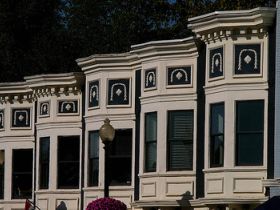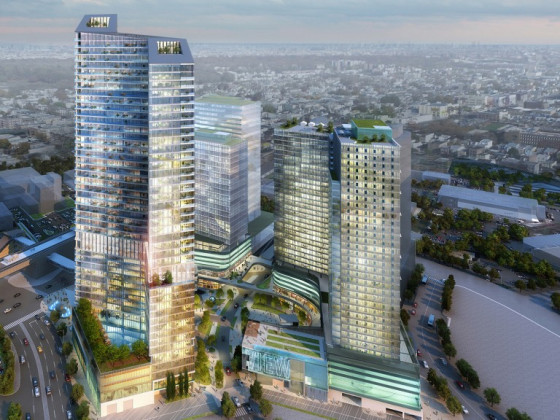 DC Housing Report -- March 2009
DC Housing Report -- March 2009
✉️ Want to forward this article? Click here.

Georgetown Rowhouses by ktylerconk
Fred Kendrick of TTR Sotheby’s International Realty, with help from Peter Clute of Coldwell Banker Residential Brokerage, puts together a monthly report on the state of the housing market in the District. Following is the most recent installment for March.
The Washington real estate market celebrated the arrival of spring in March with pending sales of single-family homes, condominiums and cooperatives increasing to their highest level since May of last year. Sales of homes and units had reversed a nine-month slide in February, and March sales rose 20% from last month and 14% from last year. These numbers do not approach the best March sales totals of the “boom” years, but they are a welcome sign of life after many months of negative reports.
The first price reports of the year were mixed as average single-family price dipped sharply while condo/co-op prices took a surprising turn upward. The expectation, however, is that prices will ultimately trend downward this year and is a natural and healthy part of the current cycle.
There is optimism for the second quarter of 2009 as consumer confidence improves and interest rates remain near an all-time low. The DC suburbs share in this optimism as March sales rose by more than 30% in Montgomery County and Northern Virginia.
Single Family
The first quarter picture shows sales climbing, largely in the lower price ranges, inventory rising moderately, and prices falling sharply for the first time in this decade.
New contracts in March reached their highest level since June of 2007. They were up 23% from February and 16% from last March. These gains were fueled largely by the 60 plus percent gain in home sales under $300,000 but also by smaller gains in homes priced from $500,000 to $700,000 and from $1 million to $1.25 million. Sales in other price ranges were down by 13% to 40% from this time a year ago.
The three month year-to-date picture shows sales up 5% from a year ago. This is the first quarterly gain in recent years and a hopeful first sign of a housing recovery, or at least stability, to come in the
months or year ahead. But as a mark of how far we have yet to go, sales so far in 2009 are still well below first quarter results of the last 10 years.
Also, all of this year’s sales gains have come from the 37% portion of the market priced under $300,000, which is ahead by more than 100% from a year ago. On the other hand, sales over $800,000 are still off by more than 30% from the first three months of 2008, with home sales over $1.5 million down by 41%.
The inventory of homes for sale at the end of the first quarter is the highest so far this year and is up 6% from the end of last year. This inventory has grown primarily in two price ranges of homes – those under $300,000 and those over $700,000 with the largest gains under $150,000 and over $1.5 million. Sales increases, however, have more than offset these inventory gains with the result that the effective inventory of homes for sale in now down to 5.3 months, by far the lowest figure in 10 months.
Prices on the other hand are now showing a substantial decline with the average price of single family homes down 22.5% from the first quarter of 2008 and the median price down 31%. These prices began a moderate fall after mid year 2008 but the sharper drop has occurred this year and is at least partially the result of the concentration of home sales in the more moderate and lower price ranges.
Housing prices are always a trailing indicator following by many months the upward or downward trends of the sales market. Consequently, it is not surprising to see home prices falling now since the sales market has been in decline since mid to late 2004. And it will not be surprising to see prices continue to decline even after the volume of sales stabilizes and then begins to climb again sometime later this year or early in 2010.
Condominiums and Cooperatives
Pending sales of condominiums and cooperatives reached their highest point in eight months, gaining 16% from February and up 11% over March of last year. The most active price range was between $300,000 and $400,000, making up 31% of March contracts, which saw a 23% increase from last year. Units priced over $400,000, 15% of the market, saw a 33% increase.
Even with the strong March the low condo/co-op sales totals in January left this year’s first quarter numbers trailing the first quarter of 2008 by 10%. For the 91% of the market under $700,000, first quarter pending sales were down 13%, but for the 9% of the market over $700,000 sales were up 53%
The average sales price of upper end condos and co-ops settled through March also showed a strong gain. For the 8% of the market above $800,000, settlements were up 107% and units over $1.5 million were up 233%. While the high-end units are just a small segment of the market, these large increases combined with sales declines in the lower end resulted in an 11% increase in average prices over year-end 2008.
For buyers, sellers and agents working in the market, this 11% increase is unexpected, but can best be explained as a bit of an anomaly caused by the distribution of actual and pending sales this year. The median price remains even with last year and is certainly a better indicator of where the market is today.
The number of available units increased by 6% from February, but is now 2% lower than the same point last year. All price categories between $150,000 and $800,000 were down compared to last year, with only the low end and high end showing increases. The inventory of units priced below $150,000 was up 63% and of units priced over $800,000 was up 66%.
With a portion of the condo inventory unlisted in MRIS, it is important for the inventory to stay at a reasonable level for a recovery to occur. The 6.04 months of inventory on the market at the end of March (down from 9.76 months in January) certainly indicates the market is improving.
Prepared by:
Peter Clute — Coldwell Banker Residential Brokerage (202-333-6100)
Fred Kendrick — TTR Sotheby’s International Realty (202-333-1212)
Data from the Greater Capital Area Association of REALTORS
See other articles related to: dclofts
This article originally published at http://dc.urbanturf.production.logicbrush.com/articles/blog/dc_housing_report_--_march_2009/818.
Most Popular... This Week • Last 30 Days • Ever

With frigid weather hitting the region, these tips are important for homeowners to ke... read »

Today, UrbanTurf offers a brief explanation of what it means to lock in an interest r... read »

An application extending approval of Friendship Center, a 310-unit development along ... read »

The 30,000 square-foot home along the Potomac River sold at auction on Thursday night... read »

The number of neighborhoods in DC where the median home price hit or exceeded $1 mill... read »
DC Real Estate Guides
Short guides to navigating the DC-area real estate market
We've collected all our helpful guides for buying, selling and renting in and around Washington, DC in one place. Start browsing below!
First-Timer Primers
Intro guides for first-time home buyers
Unique Spaces
Awesome and unusual real estate from across the DC Metro














